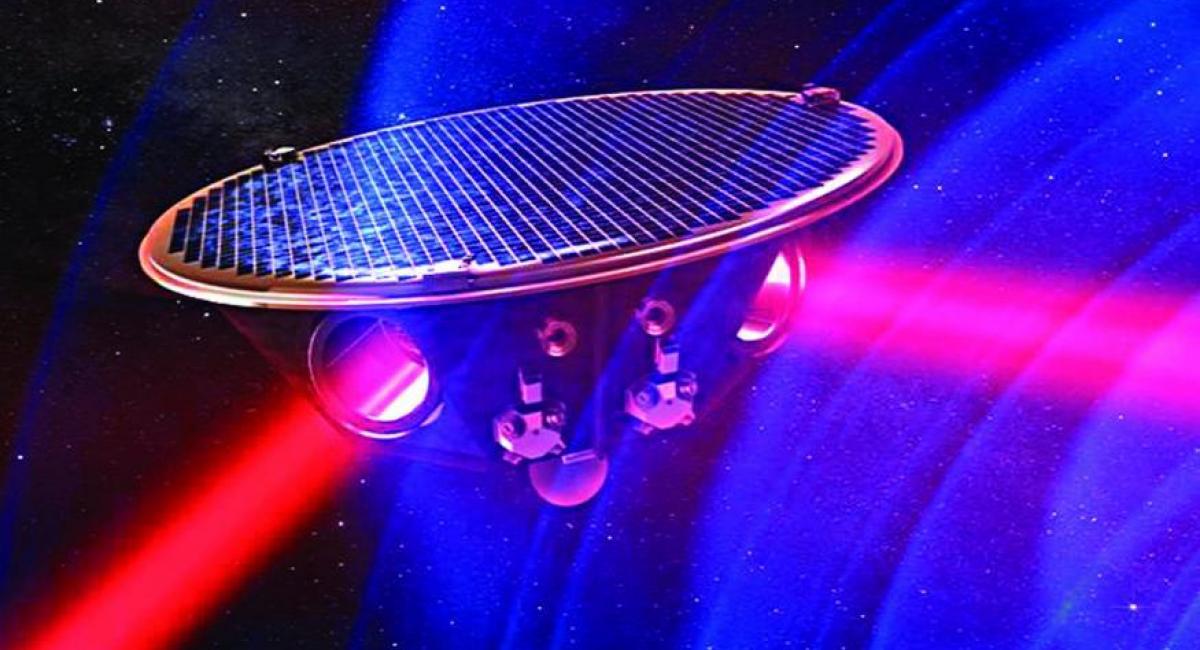Voordat een ESA-missie het lanceerplatform bereikt, moet er een aantal goedkeuringsprocedures worden doorlopen om zeker te weten dat de missie er klaar voor is. De Laser Interferometer Space Antenna (LISA), het toekomstige zwaartekrachtgolfobservatorium in de ruimte, is onlangs met vlag en wimpel geslaagd voor zijn zogeheten Mission Definition Review (MDR).
(English follows Dutch)

De MDR is bedoeld om te beoordelen en te bevestigen dat
• het huidige ontwerp van de LISA-missie haalbaar en geschikt is,
• de missievereisten voldoen aan de wetenschappelijke vereisten van LISA,
• de vereisten ver genoeg ontwikkeld zijn en passen bij de huidige fase,
• de technologische ontwikkelingen toereikend zijn voor de huidige fase, en dat
• de interfaces tussen ruimtevaartuig, instrument, grond segment en draagraket goed zijn bepaald.
“Ik ben heel tevreden dat LISA de beoordeling zo goed heeft doorstaan. Nu gaan we door naar de volgende fase. In 2018 werken we aan verdere testen, onderzoeken en technologische ontwikkeling. Het is geweldig om te zien dat LISA zoveel vooruitgang boekt”, aldus Prof. dr. Karsten Danzmann, directeur van het Max Planck-Instituut voor Gravitatiefysica (Albert Einstein-Instituut), directeur van het Instituut voor Gravitatiefysica aan de Universiteit van Hannover en leider van het LISA-consortium.
Stap verder naar detailstudie samensmeltende superzware zwarte gaten
“Geweldig dat het rapport zo positief is”, voegt Gijs Nelemans toe, leider van het Nederlandse LISA-consortium. “Weer een stap dichterbij de missie waarmee we het samensmelten van super-zware zwarte gaten in detail kunnen bestuderen.”
De lancering van LISA staat gepland voor 2034 als missie van de Europese Ruimtevaartorganisatie (ESA). De missie wordt gesteund door veel ESA-lidstaten, NASA en vele samenwerkende wetenschappers aan beide zijden van de Atlantische Oceaan.
LISA zal bestaan uit drie satellieten die samen een gelijkzijdige driehoek vormen waarvan elke zijde ongeveer 2,5 miljoen kilometer lang is. Als er zwaartekrachtgolven door de opstelling gaan, veranderen deze afstanden met een fractie van de diameter van een atoom. De belangrijkste technologieën van LISA zijn tussen eind 2015 en medio 2017 met succes gedemonstreerd in de LISA Pathfinder-missie van ESA. LISA gaat laagfrequente zwaartekrachtgolven meten met een trillingstijd van tien seconden tot meer dan een halve dag.
Dergelijke golven kunnen niet worden waargenomen met detectoren op aarde. Ze worden uitgezonden bij gebeurtenissen zoals het samensmelten van super-zware zwarte gaten met miljoenen keren de massa van onze zon in het midden van sterrenstelsels, de baanbewegingen van tienduizenden dubbelsterren in de Melkweg, en mogelijk exotische bronnen zoals kosmische snaren.
Nederlandse consortiumdeelname
De Nederlandse bijdrage aan LISA is gebundeld in het LISA-NL-consortium. Naast diverse wetenschappers van Nederlandse universiteiten bestaat dat uit de onderzoeksinstituten SRON, Nikhef, TNO en onderzoekschool NOVA. Deze Nederlandse instituten werkten eerder al mee aan de testmissie LISA Pathfinder. Nederlandse bijdragen aan de hardware voor LISA worden nog onderzocht en zouden kunnen bestaan uit optische systemen, elektronica voor de ‘fase-camera’, kalibratie en dataverwerking.
Meer informatie:
https://www.lisamission.org
http://sci.esa.int/lisa/
LISA mission passes review successfully and begins next stage of development
Before an ESA mission reaches the launch pad, it has to go through a number of approval procedures that ensure the mission´s readiness. The future space-based gravitational wave observatory, the Laser Interferometer Space Antenna (LISA), has recently passed its Mission Definition Review (MDR) with flying colors.
The MDR´s goal is to review and confirm that
• LISA´s present mission design is feasible and suitable,
• the mission requirements meet LISA´s science requirements,
• the requirements are mature and adequate to the current phase,
• the technology developments are adequate to the current phase, and
• the interfaces between spacecraft, payload, ground segment, and launcher are well defined.
“I am very satisfied that LISA passed the assessment so well. Now we are heading to the next phase. 2018 will be filled with further examinations, investigations and technology development. It’s great to see LISA making so much progress”, says Prof. Karsten Danzmann, director at the Max Planck Institute for Gravitational Physics (Albert Einstein Institute), director of the Institute for Gravitational Physics at Leibniz Universität Hannover, and LISA Consortium Lead.
Step towards detailed study of merging supermassive black holes
“Fantastic that the report is so positive”, adds Gijs Nelemans, leader of the Dutch LISA consortium. “This brings us another step closer to the mission with which we will be able to study the merging of supermassive black holes in detail.”
LISA is scheduled for launch into space in 2034 as a mission of the European Space Agency (ESA). It is supported by many ESA member states as well as NASA and many scientists are working together across the Atlantic.
LISA will consist of three satellites spanning an equilateral triangle with each side approximately 2.5 million kilometers long. Gravitational waves passing through the constellation change these distances by a fraction of the diameter of an atom. LISA´s key technologies were successfully demonstrated with ESA´s LISA Pathfinder mission, which operated from late 2015 until mid 2017.
LISA will measure low-frequency gravitational waves with oscillation periods ranging from 10 seconds to more than half a day, which cannot be detected with detectors on the Earth. These are emitted by events such as supermassive black holes with millions of times the mass of our Sun merging at the centers of galaxies, the orbital motions of tens of thousands of binary stars in our Galaxy, and possibly exotic sources such as cosmic strings.
Dutch Contribution
The Dutch contribution to LISA is concentrated in the LISA-NL consortium. Besides various scientists from Dutch universities it consists of the research institutes SRON, Nikhef, and TNO as well as the research school NOVA. These Dutch institutes previously contributed to the test mission LISA Pathfinder. Dutch contributions to the hardware for LISA are still being investigated and could include optical systems, electronics for the ‘phase camera’, calibration, and data processing.
Further information:
https://www.lisamission.org
http://sci.esa.int/lisa/


